When repairing the bathroom, to get a good result it is necessary to choose the right materials and estimate the scope of work, the amount of time required. In the article we will consider various options for finishing the bathroom using traditional and unusual materials.
Contents of the article
Ways of leveling the walls
Almost all options for finishing the bathroom provide for preliminary leveling of the walls. There are two ways – with the help of plaster and drywall. Plastering is a longer and more expensive process, but it takes up less space – plastering fills existing irregularities. Level the walls in the bathroom with drywall can be quickly and will cost less. And this is a plus. But at the same time on each wall will “leave” at least 6 cm (5 cm profile + 1.2 cm thickness of GVL). And this is a solid minus, especially in small bathrooms. Another point: to fix heavy things or equipment on the walls of drywall can be only on condition of pre-installation of tabs – a wooden bar or steel strips fixed to the wall. And this is additional costs and difficulties.
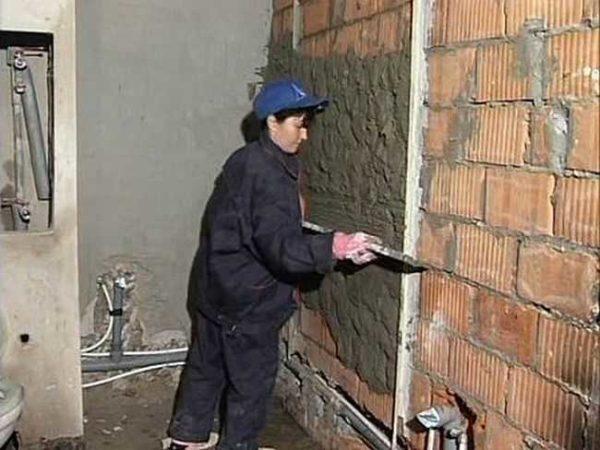
Whatever method of leveling the walls and ceiling in the bathroom you have not chosen, you need to take into account the high humidity of this room. Therefore, all materials take moisture-resistant:
After leveling the walls in any of the ways is the preparation of surfaces for finishing. Under the laying of tiles is enough evenly plastered walls or primed gypsum board. Under wallpaper and decorative plaster requires putty. Under painting the surface should be ideal, so putty is applied in several layers (usually enough two, but there are more).
There is a variant of finishing the bathroom, under which the walls are not level – PVC wall panels. They are mounted on a batten, because the degree of curvature of the walls is not important.
Tile and its types
When it comes to options for finishing the bathroom, the first thing that comes to mind is ceramic tiles. This material is ideal for wet rooms, has a lot of advantages:
All this is great, but finishing the walls in the bathroom with ceramic tiles has disadvantages. The first – a considerable cost of finishing material. The second – the labor intensity and complexity of laying, and, therefore, the high cost of services for its installation. If desired, you can put the tiles yourself, but even under these conditions cheap this repair can not be called cheap. The third disadvantage is rigidity. With shrinkage of the house due to lack of elasticity tiles can crack. Therefore, in new buildings try to choose other options for finishing the bathroom. In any case, until the main shrinkage processes.
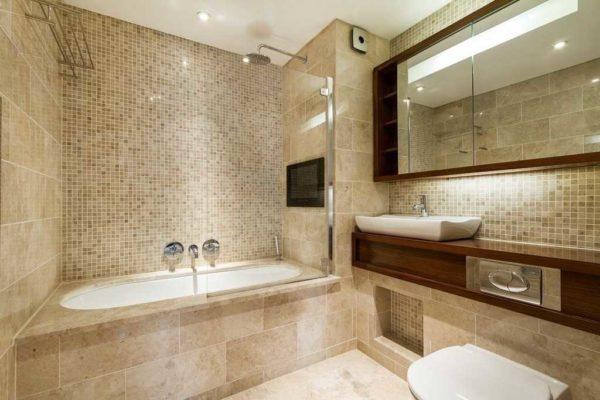
To the same category should include the finishing of the walls in the bathroom porcelain stoneware and mosaic. The technology of installation on the walls they have very similar, as well as the properties of the materials, but the cost of material and work is even higher.
Painting
Painting is a traditional way of decorating walls in wet rooms, almost forgotten for some time because of the impracticality and unattractiveness of the resulting coating. Paint was only oil, the walls were not very even (to put it mildly), in general, the look was shabby. New technologies and materials allow you to achieve a perfectly flat surface, a variety of colors – different effects. All this at low cost. This is gradually reviving the forgotten was a variant of finishing the bathroom – painting the walls.
Preparation of walls
Under painting requires a perfectly flat surface and it can be made so with the help of moisture-resistant putty. It can be applied to plaster or drywall. Regardless of the substrate, with enough skill, the surface becomes really perfect. Not a single flaw is possible.
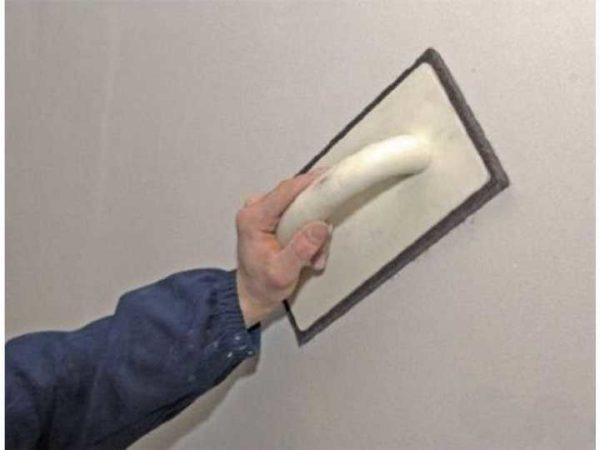
Prepared walls or ceiling are primed with a composition with antibacterial and water-repellent component, after drying, you can start applying paint.
Types of paints for the bathroom
But not all paints can be used in the bathroom, since not all of them are moisture-resistant. The following paint compositions are suitable:
- Water emulsion paints based on latex and acrylates. Acrylic water emulsion – an inexpensive option that normally tolerates high humidity, but in close proximity to the bath, shower and washbasin to use it is not worth it. Latex emulsion forms a dense waterproof film on the surface and even slightly “tightens” irregularities, if any. How to paint the walls with water emulsion paint see here.
- Alkyd paints. In appearance very similar to oil, but have better characteristics, can be glossy, semi-glossy, matte. From the advantages – has an average vapor permeability and a low price. Disadvantages – emphasizes all irregularities, over time change color – acquire a yellowish tint. Another disadvantage – they are made on the basis of organic solvents (white spirit, gasoline, turpentine), so the odor before drying is strong.
- Silicate paints. The main plus – on the walls and ceiling painted with this paint will not appear fungus or mold. There are more advantages: very high vapor resistance, strong and durable coating. Disadvantage: until the composition does not dry, it is very harmful to humans. As soon as crystallization has occurred, the coating becomes absolutely harmless, but you need to work in protective clothing and respirator and leave before drying out of the house. Another unpleasant moment: silicate paints do not “lie down” any other paints. If you want to change the type of paint, you will have to scrub everything off.
- Based on silicones. This composition is 100% waterproof. Water does not conduct in any form – in the form of steam too. Therefore, when finishing this type will have to make a very powerful ventilation.
- Chloro rubber. Paints of this type are used in swimming pools to paint bowls, so they are suitable even for walls near the bathroom or in the shower stall. But too will have to take care of good ventilation and removal of the coating before the next painting.
As you can see, there are options for finishing the bathroom with paint, and quite a few. Most can be used with a limited budget for repairs, but chlorine rubber and silicone are not very cheap.
Decorative plaster
If talking about new finishing materials for the bathroom, then first of all it is worth remembering about decorative plaster. It can be applied to relatively flat walls or on a plastered surface. Usually prefer to first level the walls, then apply decorative plaster. It refers to expensive materials, so it is desirable to minimize consumption.
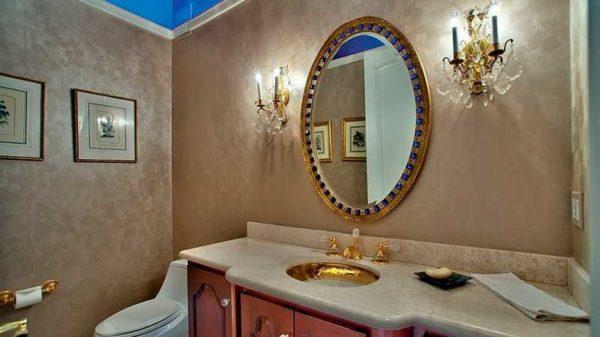
For finishing the walls of the bathroom choose moisture-resistant options, and these are mainly facade compositions. They do not change color for a long time, they can be washed with a stiff brush with detergent, but they are very rough to the touch. Options for finishing the bathroom with facade plasters are in the photo below.
One of the options for finishing the bathroom – Venetian plaster, covered with two layers of wax. With this combination of materials, water in any form just rolls off it. In terms of practicality, this option is no worse than paint, but definitely more beautiful. Minuses – high price and complexity of application.
About the ways of applying decorative plaster read here.
Wallpaper in the bathroom
Wallpaper in the bathroom is perceived by many people critically. And for nothing. This is an inexpensive and fast way to decorate the walls in the bathroom. It is hardly worth wallpapering the area near the bathtub or washbasin, but the rest of the space is very possible. Wallpaper for the bathroom should be chosen moisture-resistant (in the graphic coding is three wavy lines), preferably resistant to friction – so that you can wash them with a brush.
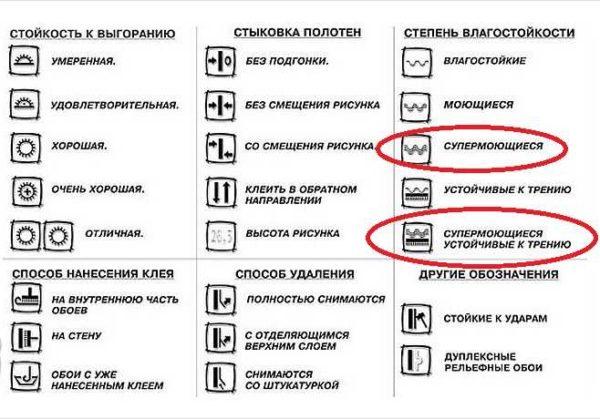
Glue to use with antibacterial additives, not forgetting to prim the walls with a composition with antiseptics. This option is probably the cheapest finishing of the walls in the bathroom and the fastest way to put it in order (provided that the walls are already leveled). And this repair will be enough for a couple of years, and then you can paste the wallpaper or choose a more durable option for finishing.
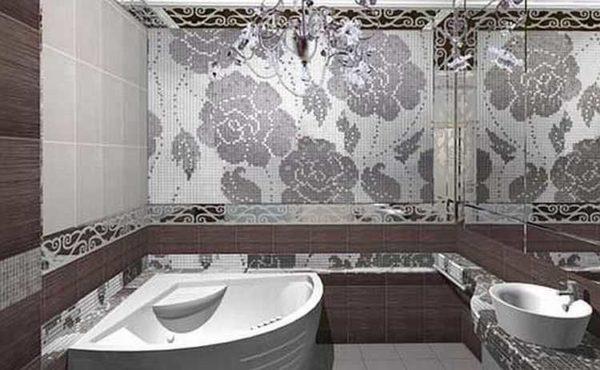
How to glue wallpaper read here.
Plastic panels
PVC wall panels are another inexpensive alternative to tiles in the bathroom. Their beauty is that the walls can not be leveled: they are attached to the battens, which will hide all the irregularities. The second advantage – they are inexpensive and mounted quickly. Another plus – a large number of colors, including plastic panels, imitating laid ceramic tiles, mosaics, decorative panels.
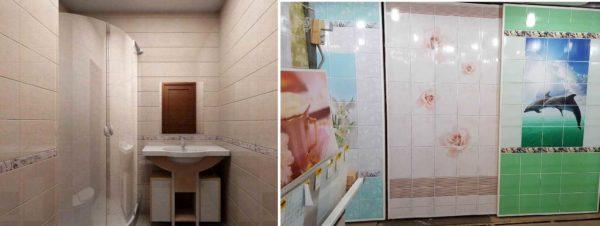
More positive points: under the wall plastic panels can easily hide all communications, and they are also easy to clean. But in order to under the finish did not get mold, the walls must be primed with a composition with antiseptic and provide good ventilation.
The disadvantages of this method of finishing the bathroom – the trim takes away a pretty solid volume, which is important. And the second disadvantage – the panels are fragile and with a significant amount of force in them are crumpled lintels. By hitting with an elbow, punch through the bars of normal quality will not penetrate, but the dent will be sure, and it spoils the appearance.
Detailed installation of plastic panels is described here.
Non-standard options for finishing the bathroom
Some finishing materials are not very suitable for operation in conditions of high humidity, but, with certain treatment, they can be used there. Such materials include wood and natural and artificial stone.
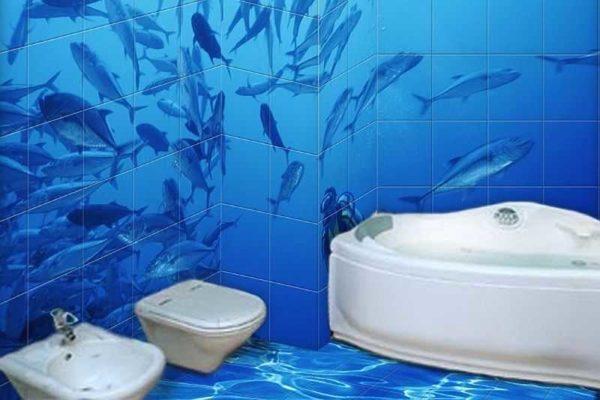
There are also new materials for wall decoration, which by their characteristics are suitable for the bathroom, but due to the fact that they are developed recently, are still little used. These materials include wall linoleum and thin PVC panels.
Here about all these finishing materials and talk about in this section.
Wall linoleum
This material is quite new. It is produced by Tarkett and is called Wallgard. Developed as a coating for walls in medical institutions because it is resistant to water and chemicals, can be washed many times, and even with the use of disinfectants. In appearance resembles a flexible sheet of plastic with a thickness of 1.2 mm, sold in rolls 2 meters wide, cut with scissors.
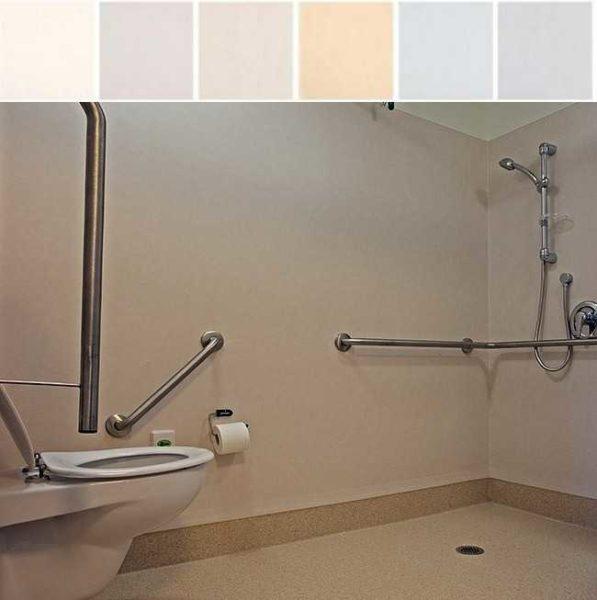
While the colors are not so many – the material is new, but since it has aroused active interest, for sure soon the range will be expanded. For now, if you prefer calm tones in the finish and matte surfaces, you can use wall linoleum.
Sheets are mounted on flat walls, between each other are welded with a special soldering iron with glue cord. You can use cold welding (glue), but the tightness of this connection is much lower.
PVC panels without partitions
There are PVC panels for finishing the walls without partitions. These are sheets of plastic with an applied pattern. The thickness of plastic 2-3 mm, the size of the plates 955 * 480 mm or so. In Russia are produced so far by one company – the company “Regul” produces the material “Decopan”. One sheet costs 215 rubles, that is, the material belongs to the category of inexpensive.
It is mounted on glue on flat walls, cut with scissors. In general, a promising option for economy finishing walls in the bathroom. Will probably be to the liking of cottagers – creates a 100% water-repellent surface, weighs little, mounted simply.
Natural and decorative stone
If you are looking for non-standard options for finishing the bathroom, look at the flagstone – sawed into thin plates of natural stone – flagstone. The most suitable is granite flagstone, as it is not hygroscopic, but can be used and other types. The laid stone is usually covered with varnish on top, which is an additional protection against moisture.
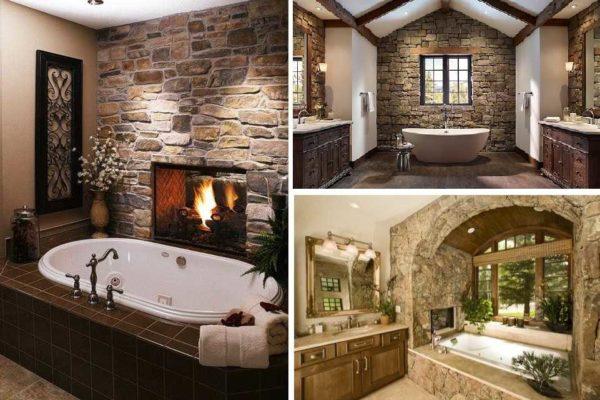
Another option is marble. But this is an expensive material that looks only in spacious rooms. For finishing bathrooms it is not often used, because it reacts badly to contact with water, and it is hard to protect it. Very difficult installation – the slabs are large, weigh a lot, only professionals can cope.
When laying natural stone, a special adhesive composition (for natural stone) is used. The technique is similar to laying tiles, only you have to pick up each element.
Natural stone, of course, beautiful, but heavy and expensive. The slabs have an arbitrary shape, which makes their laying very difficult. These problems do not exist if you use artificial decorative stone. It is made on the basis of gypsum and cement. For finishing the walls in the bathroom use cement, since gypsum is hygroscopic and does not react well to getting wet.
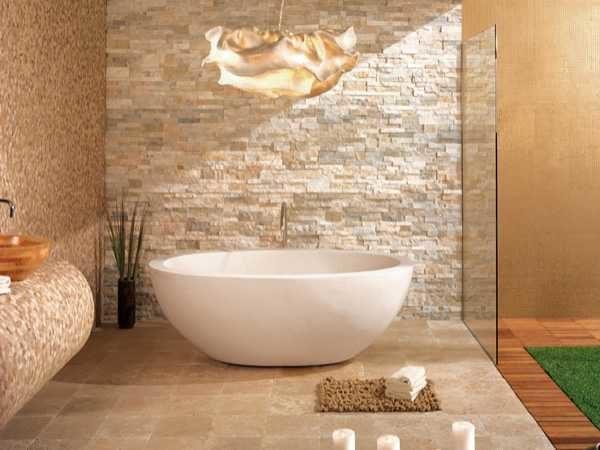
Laying decorative stone on the walls is a little more complicated than working with ceramic tiles. Each collection consists of a set of fragments in the form of small bricks of different shapes. They clash with each other, resulting in an uneven but picturesque surface. In order not to make a mistake when laying, the fragments are first laid out on the floor, selecting a combination of colors and sizes of elements. When the “picture” satisfies” decorative stone alternately transferred to the walls.
Options for finishing the bathroom with decorative stone are numerous, but most often the stone is present only in fragments. They decorate one wall or even only part of it. The rest of the space is most often painted or, as in the photo above, decorated with mosaic. These types of materials are very well combined.
Wood
In our country, wood for finishing the bathroom is used very rarely – it changes size when the humidity changes, deteriorates faster and loses its appearance. So it is not the most successful option, although, without a doubt, looks beautiful.

To improve the situation help impregnations that preserve the attractive appearance of wood even on the street. These are compositions based on oils and wax. Many of them simultaneously with protection give wood color. It can be whitened, made darker, even painted in blue, pink or other colors – there are different tints.
Such options for finishing the bathroom look cozy and warm, not cold, as when using tiles. The disadvantage of this type of finishing is the need for regular maintenance of wood with the use of special means.

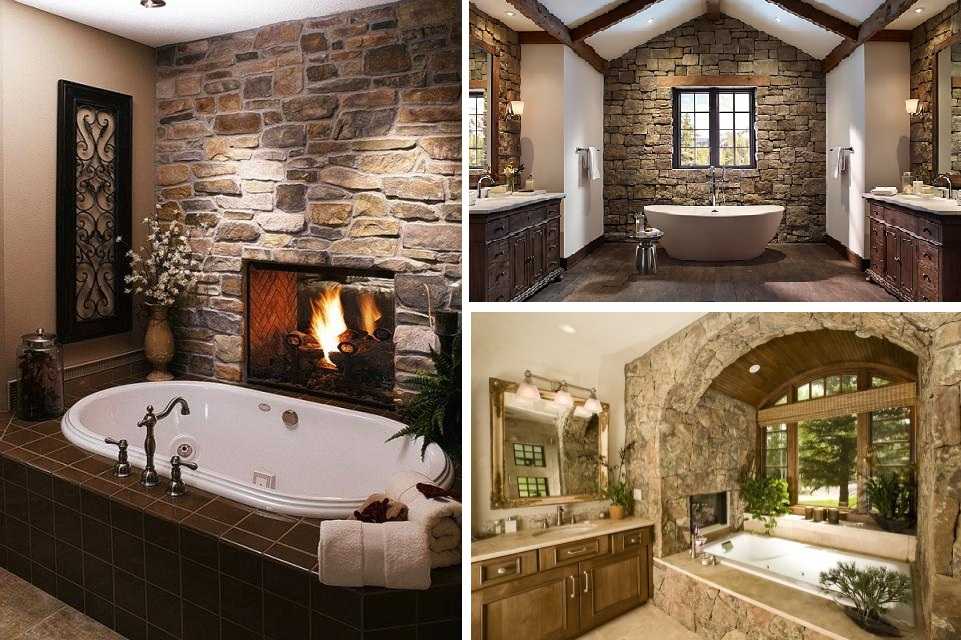

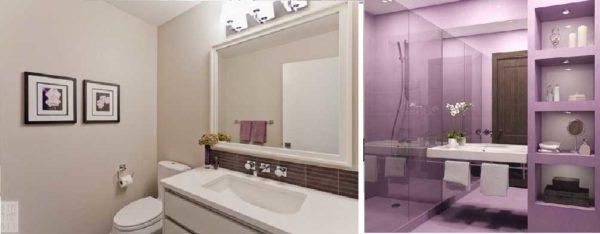
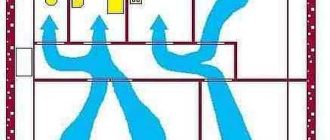
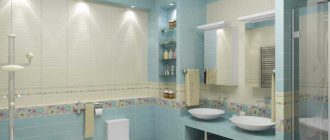
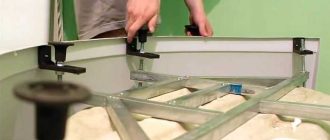
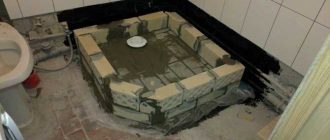
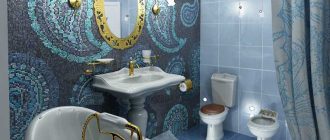
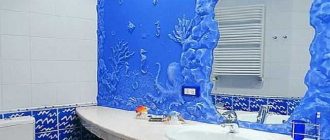
I recently redid my bathroom with some fresh tiles and it was a game-changer! The new materials made everything pop, while the classic accents gave it character. Totally stoked about how it all came together—definitely worth the effort! Who knew bathroom updates could be so fun?